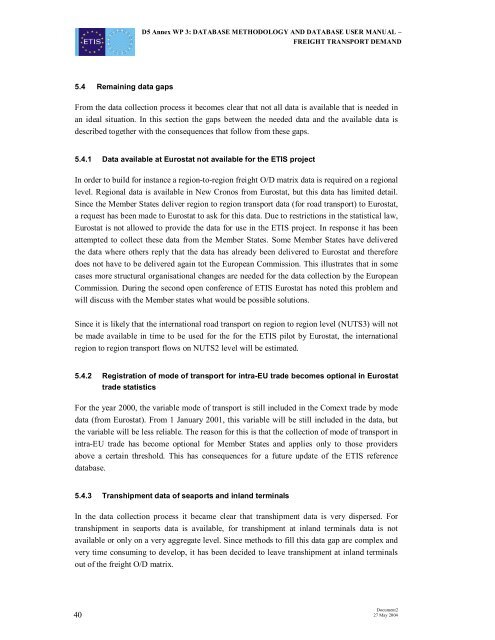D5 Annex report WP 3: ETIS Database methodology ... - ETIS plus
D5 Annex report WP 3: ETIS Database methodology ... - ETIS plus
D5 Annex report WP 3: ETIS Database methodology ... - ETIS plus
Create successful ePaper yourself
Turn your PDF publications into a flip-book with our unique Google optimized e-Paper software.
<strong>D5</strong> <strong>Annex</strong> <strong>WP</strong> 3: DATABASE METHODOLOGY AND DATABASE USER MANUAL –<br />
FREIGHT TRANSPORT DEMAND<br />
5.4 Remaining data gaps<br />
From the data collection process it becomes clear that not all data is available that is needed in<br />
an ideal situation. In this section the gaps between the needed data and the available data is<br />
described together with the consequences that follow from these gaps.<br />
5.4.1 Data available at Eurostat not available for the <strong>ETIS</strong> project<br />
In order to build for instance a regiontoregion freight O/D matrix data is required on a regional<br />
level. Regional data is available in New Cronos from Eurostat, but this data has limited detail.<br />
Since the Member States deliver region to region transport data (for road transport) to Eurostat,<br />
a request has been made to Eurostat to ask for this data. Due to restrictions in the statistical law,<br />
Eurostat is not allowed to provide the data for use in the <strong>ETIS</strong> project. In response it has been<br />
attempted to collect these data from the Member States. Some Member States have delivered<br />
the data where others reply that the data has already been delivered to Eurostat and therefore<br />
does not have to be delivered again tot the European Commission. This illustrates that in some<br />
cases more structural organisational changes are needed for the data collection by the European<br />
Commission. During the second open conference of <strong>ETIS</strong> Eurostat has noted this problem and<br />
will discuss with the Member states what would be possible solutions.<br />
Since it is likely that the international road transport on region to region level (NUTS3) will not<br />
be made available in time to be used for the for the <strong>ETIS</strong> pilot by Eurostat, the international<br />
region to region transport flows on NUTS2 level will be estimated.<br />
5.4.2 Registration of mode of transport for intraEU trade becomes optional in Eurostat<br />
trade statistics<br />
For the year 2000, the variable mode of transport is still included in the Comext trade by mode<br />
data (from Eurostat). From 1 January 2001, this variable will be still included in the data, but<br />
the variable will be less reliable. The reason for this is that the collection of mode of transport in<br />
intraEU trade has become optional for Member States and applies only to those providers<br />
above a certain threshold. This has consequences for a future update of the <strong>ETIS</strong> reference<br />
database.<br />
5.4.3 Transhipment data of seaports and inland terminals<br />
In the data collection process it became clear that transhipment data is very dispersed. For<br />
transhipment in seaports data is available, for transhipment at inland terminals data is not<br />
available or only on a very aggregate level. Since methods to fill this data gap are complex and<br />
very time consuming to develop, it has been decided to leave transhipment at inland terminals<br />
out of the freight O/D matrix.<br />
40<br />
Document2<br />
27 May 2004
















